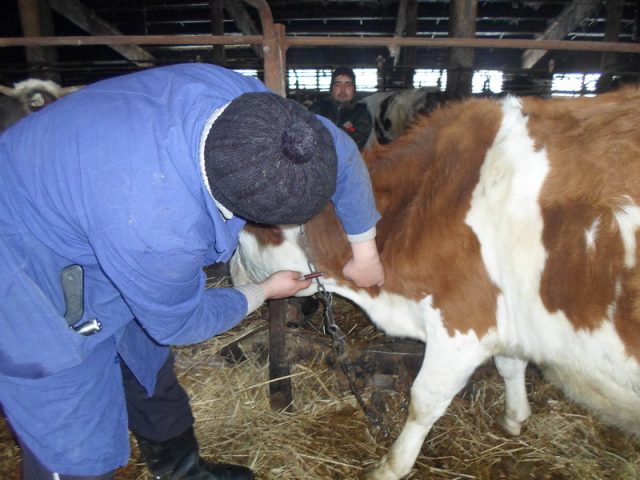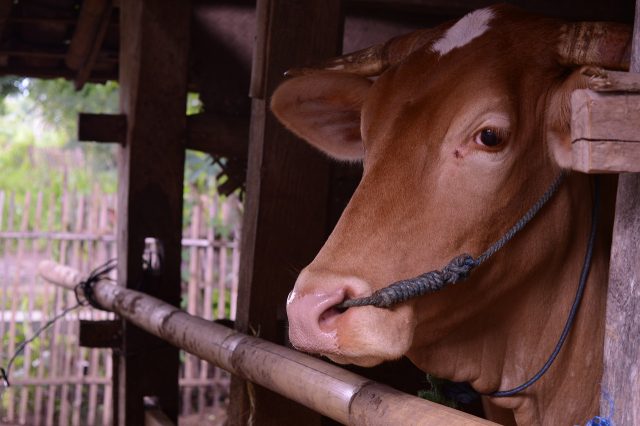Content
Taking blood from cattle is considered a rather difficult and traumatic procedure. In connection with different types of diseases, this procedure is done quite often. Today, blood is taken from cows from the tail vein, jugular and milk veins. To simplify the work, vacuum syringes have been developed, thanks to which the procedure for taking blood from the tail vein becomes completely safe.
Preparing for blood sampling from cattle
Typically, cows take blood from the jugular vein in the upper third of the neck. The volume of the obtained material for research should not be less than 5 ml with anticoagulant 0.5 M EDTA.
Before starting the procedure, the used needles should be sterilized first, using boiling for these purposes. It is important to keep in mind that each cow must be harvested with a new needle.
The place of collection must be disinfected. For disinfection, use alcohol or 5% iodine solution. During sampling, the animal must be securely fixed - the head is tied.
After the material for research has been taken, it is worth tightly closing the tube and inverting it several times to mix with the anticoagulant. In this case, shaking is not allowed. Each tube is numbered according to the inventory.
The most effective method is to draw blood from the tail vein. In this case, the cow does not need to be fixed. It is recommended to store the tubes in the future at a temperature range from + 4 ° С to + 8 ° С. A refrigerator is perfect for these purposes. Do not use a freezer. If clots appear in the taken sample, it is unsuitable for further research.
Methods for taking blood from cows
Today there are several methods of taking blood from cattle. It is taken from such veins:
- jugular;
- dairy;
- tail vein.
Before carrying out the procedure, it is recommended to pre-fix the animal, which will exclude injury. In this state, the cow will also not be able to tip the tube. Before the procedure, you will need to disinfect the blood sampling site using a solution of phenol, alcohol or iodine.
Taking a sample from the jugular vein is one of the most popular methods. Typically, the procedure is carried out early in the morning or before the cow is fed. For the procedure, the head of the animal is tied and fixed in a motionless state. The needle must be inserted at an acute angle, with the tip always directed towards the head.
From the milk vein, it is allowed to take blood for research only from an adult. The milk veins are located on the side of the udder and extend down the belly. Through them, the mammary glands are supplied with blood and nutrients. It should be noted that the more developed the milk veins are, the more milk can be obtained from the cow.
It is safest to take samples for research from the tail vein. The injection site, as in other cases, must be disinfected. If you choose the injection site at the level of 2 to 5 vertebrae, the procedure will go smoother.
Taking blood from cows from the tail vein
Practice shows that taking blood from the tail vein for research is the safest option. For these purposes, you can use a regular needle or use a special vacuum system. Such systems already include special tubes that contain an anticoagulant and the required pressure, which allows blood from the tail vein to flow smoothly into the container.
Before taking a sample from the tail vein, it is necessary to disinfect the injection site with alcohol or iodine solution. After that, the cow's tail is lifted and held by the middle third. In this case, the needle must be inserted smoothly into the tail vein, the angle of inclination must be 90 degrees. The needle is usually inserted all the way.
This method of collection has a large number of advantages:
- the sample taken is completely sterile;
- there are practically no clots in the test tube, as a result of which all samples are suitable for research;
- this procedure does not take much time. An experienced veterinarian can call for samples from 200 animals for 60 minutes;
- when using this method, there are no side effects, while the chance of injury to cattle is minimized;
- contact with blood is minimal;
- the animal does not experience stress, the usual level of milk yield is maintained.
This method is most often used on large farms, where it is necessary to take a large number of samples in a short period of time.
Taking blood from cattle from the jugular vein
If it is necessary to take blood from the jugular vein, it is recommended to insert the needle at the border, where the transition of the upper third of the neck to the middle occurs. The first step is to induce sufficient filling of the vein and minimize its mobility. For these purposes, it is recommended to compress the vein with a rubber band or fingers.
During the puncture, you will need to hold a syringe with a needle in your hand so that the direction of the needle coincides with the line of travel of the vein to be punctured. Make sure that the needle point is directed upwards towards the head. The needle should be inserted at an angle of 20 to 30 degrees. If the needle is in a vein, blood will flow from it.
Before removing the needle from the jugular vein of the cow, first remove the rubber tourniquet and pinch the vein with your fingers. It is necessary to squeeze just above the place where the needle is located. The needle is gradually removed, and it is recommended to squeeze the injection site with a cotton swab for some time, which will prevent the formation of bruises on the animal's body. At the end of the procedure, the venipuncture site is disinfected with alcohol or iodine tincture and treated with Collodion solution.
Taking blood from the milk vein
In this case, it must be borne in mind that blood sampling from the mammary gland can only be done in adults. The vein required can be found on the side of the udder.
Before taking a sample, it is recommended to pre-fix the animal. As a rule, the presence of several people is required for the procedure. The first step is to shave off or cut off the hair from the place where you plan to make a puncture with a needle. After that, the prepared area is disinfected using alcohol or iodine solution.
In good visibility there should be a kind of small tubercle, where it is recommended to insert the needle. Since it is quite easy to harm a cow, the needle is inserted as carefully as possible. It must be inserted at an angle, parallel to the course of the vein, until the needle precisely hits it and dark venous blood appears.
This method has several advantages:
- acceptable cost of materials required for research;
- collecting samples does not take much time;
- spattering of blood is minimal.
Despite this, there are significant disadvantages:
- the risk of injury to the cow is quite high;
- have to come into contact with the blood of the animal;
- during blood sampling, the animal experiences severe stress, since the needle is inserted into the most tender place on the body;
- it is quite difficult to carry out this procedure.
Thanks to new technologies, this method is outdated; it is practically not used in research.
Features of vacuum blood sampling
The use of vacuum systems has a significant advantage, since after sampling the blood immediately enters a special tube, as a result of which there is no contact of the veterinary personnel with the taken sample.
Such systems consist of a vacuum syringe, which serves as a container, and a special needle. The connection to the anticoagulant is carried out inside a vacuum container.
If we consider the advantages of vacuum blood sampling, then we can highlight the following:
- within 2 hours there is an opportunity to take samples for research from 200 animals;
- it is not required to fix the animal in a motionless state before starting the procedure;
- at all stages of sampling, there is no direct contact of the veterinarian with blood;
- since blood does not come into contact with objects from the environment, the risk of spreading infection is reduced to zero;
- the animal practically does not experience stress during the procedure.
As a result of the fact that cattle do not experience stress, milk yield does not decrease in cows.
Conclusion
Taking blood from cows from the tail vein is the most popular and painless method for the animal. As practice shows, this method of sampling does not require much time, as a result of which a large number of samples from cattle can be taken in a short period.










